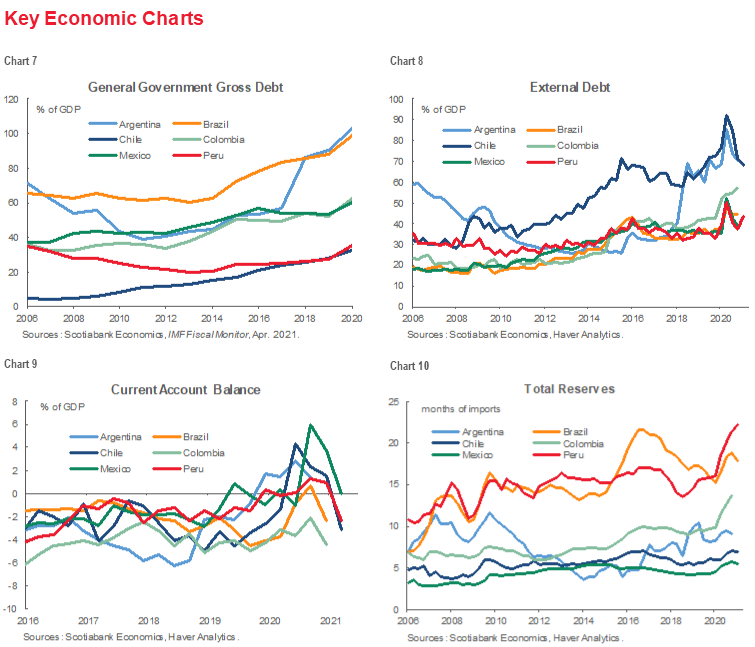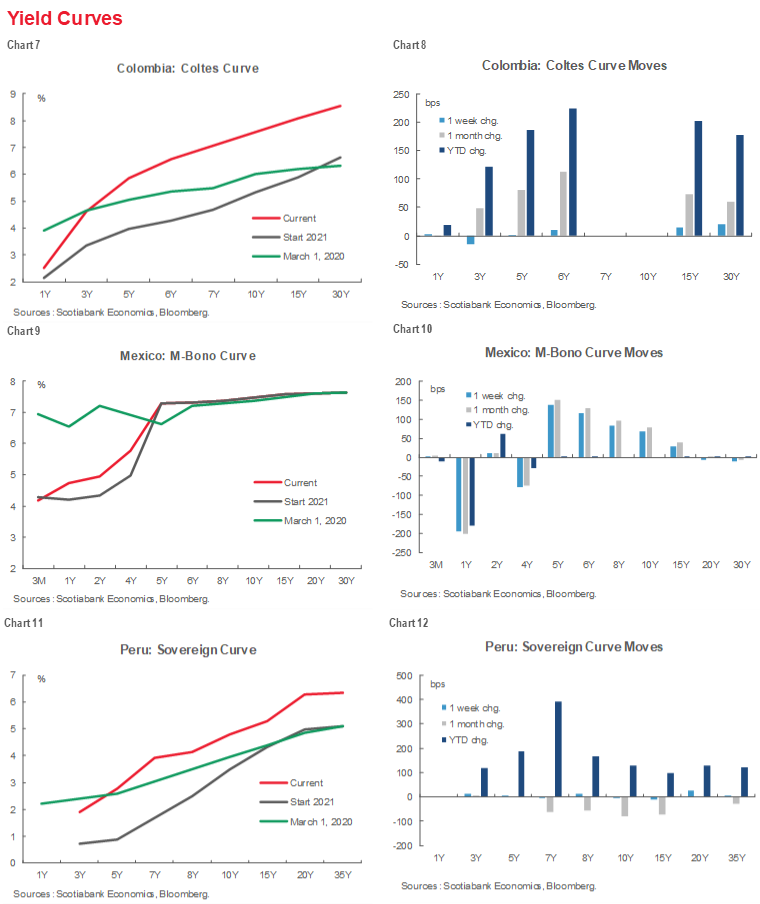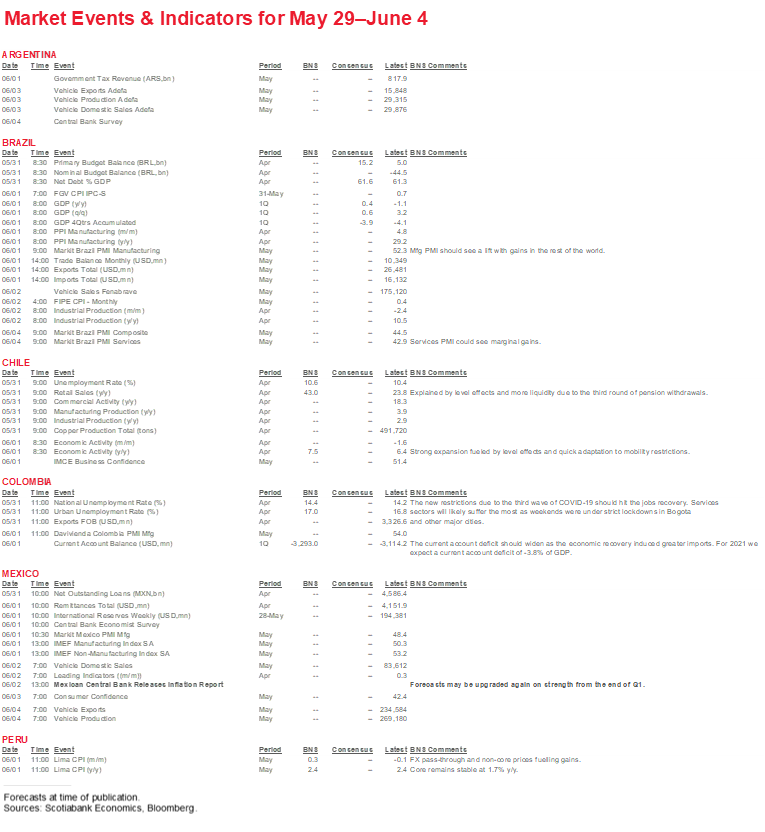- Latam’s sovereign yield curves have risen and steepened in line with global developments so far in 2021. They have also remained notably stable as capital inflows have continued despite the recent rise of political uncertainty in some countries.
- Argentina’s explosive third-wave surge in COVID-19 is not being mirrored elsewhere in the region.
YIELD CURVES MOVING ON GLOBAL DEVELOPMENTS
- Since the beginning of 2021, sovereign yield curves across Latam have progressively risen and in most cases steepened in response to global developments in the pandemic, inflation prints, and shifts in developed-market monetary policy expectations (see the Yield Curves section, pp. 6–7). Brazil’s initiation of the region’s first monetary-policy rate hikes has pushed its sovereign curve up the most markedly amongst its Latam peers, but all of the region’s curves have come to reflect market anticipation of higher policy rates by late-2021 or the first half of 2022. Hikes by the BCB’s Copom have helped to propel the BRL to the top of the emerging-market FX ranks (charts 1 and 2), a major turnaround anticipated by our forecasts.

- It’s notable that the shape of sovereign yield curves has changed little since the onset of local political uncertainty during the past few weeks in Chile, Colombia, and Peru. If anything, the region’s curves have flattened somewhat (table 1), in line with developed-market yields, as capital flows have continued to remain solid into Latam.

ARGENTINA’S THIRD WAVE EXPLODES
- Argentina’s recent explosion in new COVID-19 cases has focused a fresh spotlight on the pandemic’s evolution in Latam, but developments elsewhere in the region are mixed. Argentina hit an initial third surge in new COVID-19 cases in March, followed by a small breather in April, only to see new case numbers take off again in May (Key COVID-19 charts 7 and 8). As a result, the authorities announced on Thursday, May 20, that their first strict lockdown on most activities in 2021 would go into effect on Monday, May 31.
- Colombia’s new COVID-19 infection numbers have also remained stubbornly high (Key COVID-19 charts 7 and 9). A combination of some loosening in restrictions and a possible breakdown in physical distancing during political protests has combined to sustain the country’s third wave amidst a relatively slow roll-out of vaccinations compared with the rest of Latam (chart 3).

- Still, in terms of cumulative per capita COVID-19-related deaths, official statistics imply that, outside of Brazil and Peru, the rest of the Latam-6 hasn’t fared much worse than the US (table 2). That said, official statistics clearly undercount COVID-19 deaths everywhere in the world.

- Chile continues to remain miles ahead of the rest of Latam—and much of the world—with its exemplary roll-out of vaccinations (chart 3, again). But as vaccination rates start to ramp up gradually across the rest of Latam, new infection numbers (Key COVID-19 chart 7, again) and positivity rates (chart 4) continue to trend downward in Chile, Mexico, and Peru.









| LOCAL MARKET COVERAGE | |
| CHILE | |
| Website: | Click here to be redirected |
| Subscribe: | carlos.munoz@scotiabank.cl |
| Coverage: | Spanish and English |
| COLOMBIA | |
| Website: | Forthcoming |
| Subscribe: | jackeline.pirajan@scotiabankcolptria.com |
| Coverage: | Spanish and English |
| MEXICO | |
| Website: | Click here to be redirected |
| Subscribe: | estudeco@scotiacb.com.mx |
| Coverage: | Spanish |
| PERU | |
| Website: | Click here to be redirected |
| Subscribe: | siee@scotiabank.com.pe |
| Coverage: | Spanish |
| COSTA RICA | |
| Website: | Click here to be redirected |
| Subscribe: | estudios.economicos@scotiabank.com |
| Coverage: | Spanish |
DISCLAIMER
This report has been prepared by Scotiabank Economics as a resource for the clients of Scotiabank. Opinions, estimates and projections contained herein are our own as of the date hereof and are subject to change without notice. The information and opinions contained herein have been compiled or arrived at from sources believed reliable but no representation or warranty, express or implied, is made as to their accuracy or completeness. Neither Scotiabank nor any of its officers, directors, partners, employees or affiliates accepts any liability whatsoever for any direct or consequential loss arising from any use of this report or its contents.
These reports are provided to you for informational purposes only. This report is not, and is not constructed as, an offer to sell or solicitation of any offer to buy any financial instrument, nor shall this report be construed as an opinion as to whether you should enter into any swap or trading strategy involving a swap or any other transaction. The information contained in this report is not intended to be, and does not constitute, a recommendation of a swap or trading strategy involving a swap within the meaning of U.S. Commodity Futures Trading Commission Regulation 23.434 and Appendix A thereto. This material is not intended to be individually tailored to your needs or characteristics and should not be viewed as a “call to action” or suggestion that you enter into a swap or trading strategy involving a swap or any other transaction. Scotiabank may engage in transactions in a manner inconsistent with the views discussed this report and may have positions, or be in the process of acquiring or disposing of positions, referred to in this report.
Scotiabank, its affiliates and any of their respective officers, directors and employees may from time to time take positions in currencies, act as managers, co-managers or underwriters of a public offering or act as principals or agents, deal in, own or act as market makers or advisors, brokers or commercial and/or investment bankers in relation to securities or related derivatives. As a result of these actions, Scotiabank may receive remuneration. All Scotiabank products and services are subject to the terms of applicable agreements and local regulations. Officers, directors and employees of Scotiabank and its affiliates may serve as directors of corporations.
Any securities discussed in this report may not be suitable for all investors. Scotiabank recommends that investors independently evaluate any issuer and security discussed in this report, and consult with any advisors they deem necessary prior to making any investment.
This report and all information, opinions and conclusions contained in it are protected by copyright. This information may not be reproduced without the prior express written consent of Scotiabank.
™ Trademark of The Bank of Nova Scotia. Used under license, where applicable.
Scotiabank, together with “Global Banking and Markets”, is a marketing name for the global corporate and investment banking and capital markets businesses of The Bank of Nova Scotia and certain of its affiliates in the countries where they operate, including; Scotiabank Europe plc; Scotiabank (Ireland) Designated Activity Company; Scotiabank Inverlat S.A., Institución de Banca Múltiple, Grupo Financiero Scotiabank Inverlat, Scotia Inverlat Casa de Bolsa, S.A. de C.V., Grupo Financiero Scotiabank Inverlat, Scotia Inverlat Derivados S.A. de C.V. – all members of the Scotiabank group and authorized users of the Scotiabank mark. The Bank of Nova Scotia is incorporated in Canada with limited liability and is authorised and regulated by the Office of the Superintendent of Financial Institutions Canada. The Bank of Nova Scotia is authorized by the UK Prudential Regulation Authority and is subject to regulation by the UK Financial Conduct Authority and limited regulation by the UK Prudential Regulation Authority. Details about the extent of The Bank of Nova Scotia's regulation by the UK Prudential Regulation Authority are available from us on request. Scotiabank Europe plc is authorized by the UK Prudential Regulation Authority and regulated by the UK Financial Conduct Authority and the UK Prudential Regulation Authority.
Scotiabank Inverlat, S.A., Scotia Inverlat Casa de Bolsa, S.A. de C.V, Grupo Financiero Scotiabank Inverlat, and Scotia Inverlat Derivados, S.A. de C.V., are each authorized and regulated by the Mexican financial authorities.
Not all products and services are offered in all jurisdictions. Services described are available in jurisdictions where permitted by law.